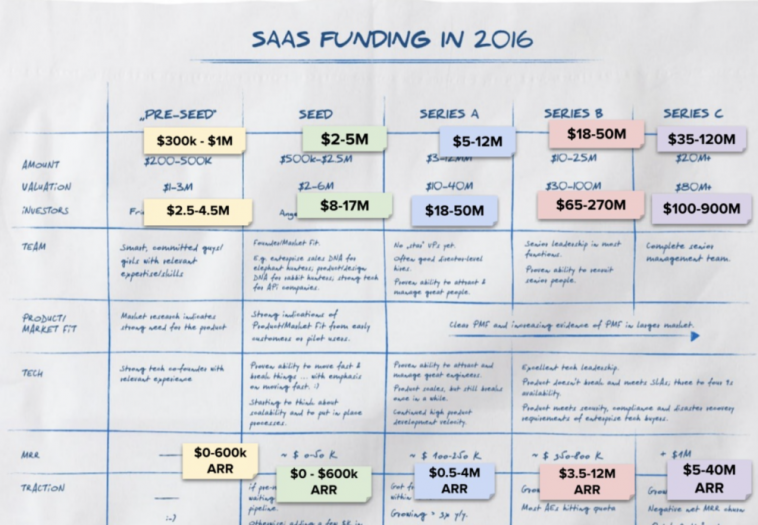- Like
- SHARE
- Digg
- Del
- Tumblr
- VKontakte
- Flattr
- Buffer
- Love This
- Save
- Odnoklassniki
- Meneame
- Blogger
- Amazon
- Yahoo Mail
- Gmail
- AOL
- Newsvine
- HackerNews
- Evernote
- MySpace
- Mail.ru
- Viadeo
- Line
- Comments
- Yummly
- SMS
- Viber
- Telegram
- JOIN
- Skype
- Facebook Messenger
- Kakao
- LiveJournal
- Yammer
- Edgar
- Fintel
- Mix
- Instapaper
- Copy Link
The SaaS Funding Napkin
What began as a blog post in 2016 has evolved into a yearly exploration and survey to founders and investors to discover what it really takes to raise capital for SaaS companies.
Christoph Janz, Founding Partner at Point 9 Capital, gives us his data-backed insight into what investors are looking for in the year ahead.
He simplifies and distills the answers to attracting investors to fit onto the back of a napkin.
The Evolution of SaaS Funding From 2016 to 2021
Christoph shared the fundraising numbers through every round from Pre-Seed to Series C. He focused on several specific metrics, including Round Size, Valuation, and ARR & MRR. (Originally, in 2016, Point 9 measured MRR, but they have since changed their focus to ARR).
Pre-Seed Round:
- Round Size – 2016: $200K – $500K. 2021: $300K – $1M.
- Valuation – 2016: $1M – $3M. 2021: $2.5M – $4.5M.
- ARR/MRR – 2016 (MRR): $0. 2021(ARR): $0 – $600K.
Seed Round:
- Round Size – 2016: $500K – $2.5M. 2021: $2M – $5M.
- Valuation – 2016: $2M – $6M. 2021: $8M – $12M.
- ARR/MRR – 2016(MRR): $0 – $50K. 2021(ARR): $0 – $600K.
Series A:
- Round Size – 2016: $3M – $12M. 2021: $5M – $12M.
- Valuation – 2016: $10M – $40M. 2021: $18M – $50M.
- ARR/MRR – 2016 (MRR): $100K – $250K. 2021 (ARR): $0.5M – $4M
Series B:
- Round Size – 2016: $10M – $25M. 2021: $18M – $50M.
- Valuation – 2016: $30M – $100M. 2021: $65M – $270M.
- ARR/MRR – 2016 (MRR): $350K – $800K. 2021 (ARR): $3.5M – $12M.
Series C:
- Round Size – 2016: $20M+. 2021: $35M – $120M.
- Valuation – $80M+ 2021: $100M – $900M.
- ARR/MRR – 2016 (MRR): 1M+. 2021 (ARR): $5M – $40M.
An overall pattern emerges from the data: As years go by, each financing round appears to increase notably from 2016 to 2021.

Want more? Enter your email below for the latest SaaStr updates
What Are Investors Looking For?
The answer varies depending on the financing round. Christoph points out some of the differences depending on the funding stage.
Pre-Seed: “What investors really want to know at this very early stage is why you’re convinced that you found a big problem that you are uniquely qualified to solve better than anyone else.”
Seed: “What investors are looking for at the seed stage is some sign of product-market fit. What we are looking for is that there are some happy users that we can use as a proxy, and that can give us the confidence that product-market fit is in the making.”
Series A: “People will look at numbers, but there are many other important points…like have you already been able to make some good senior hires? What’s the product velocity? And so on.”
Series B & Series C: “In comparison to pre-seed, seed or Series A, [it just] gets more and more quantitative at Series B and Series C, because everything you’re doing tends to show in the numbers.”
Key Takeaways:
- In terms of valuation and round sizes, there seems to be a shift over the years in the stages of investment amounts. You could nearly move the columns of the napkin over a step.
- Expectations have grown too from investors. These days, higher ARR is important.
- However, the hottest 10 – 20% defy all the rules. An exceptional team in a hot market can raise Series A style at the pre-seed stage or Series B style at the seed stage.


